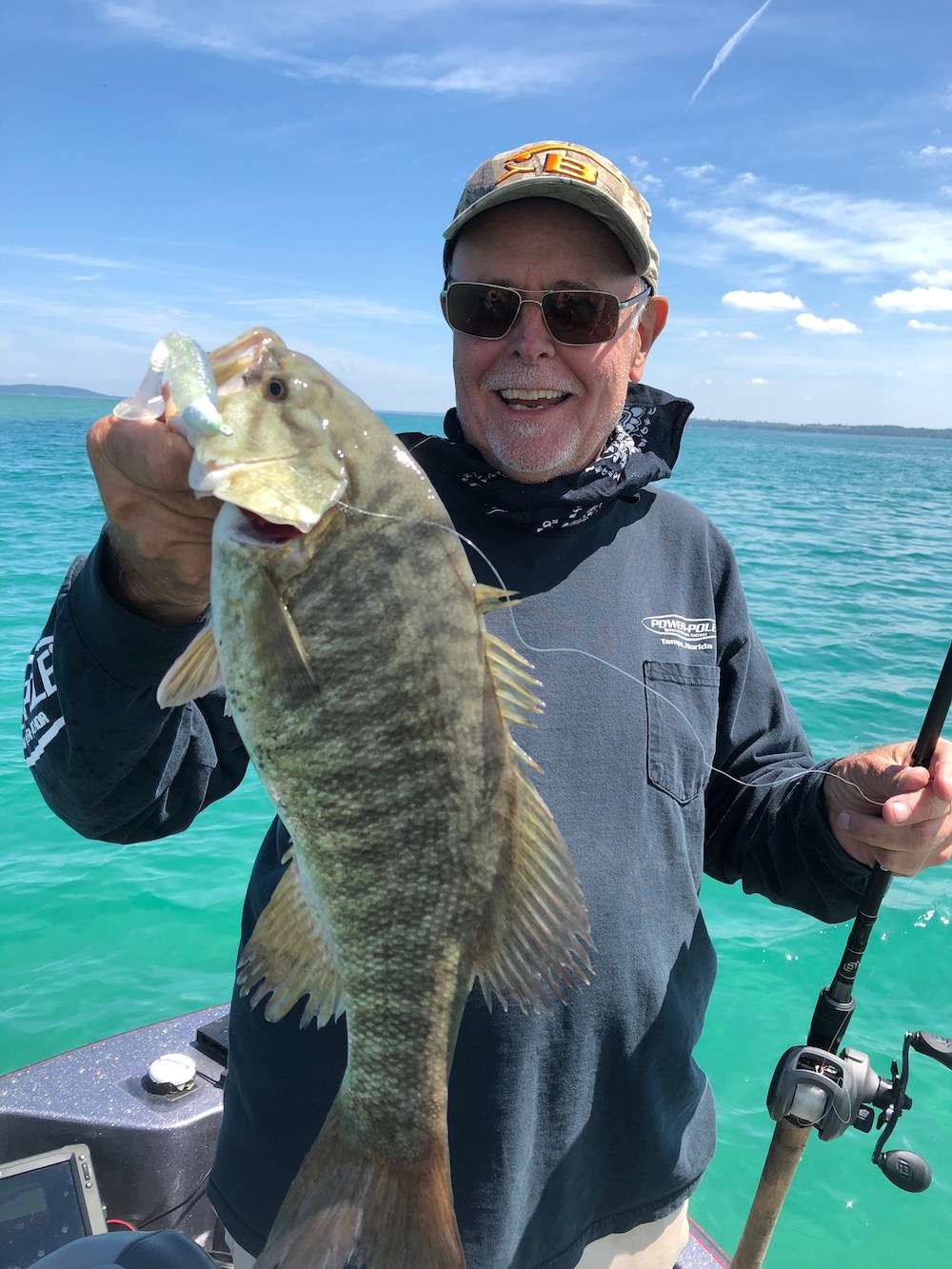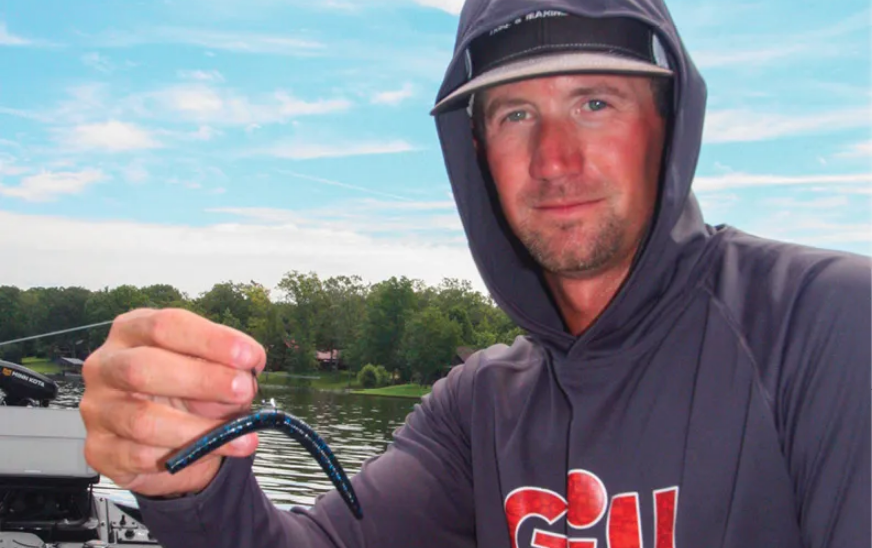
With his lanky frame, laid-back demeanor and soft Oklahoma drawl, Luke Palmer comes across as the quintessential small-town American guy — so much so that older B.A.S.S. members might easily envision a Norman Rockwell portrait of Palmer fishing in a wooden rowboat gracing the cover of a 1950s-era Saturday Evening Post magazine (to all readers below age 30, that was once a very popular publication). “The town I’m from [Coalgate] is a good two hours from Tulsa and has a population of only 3,000,” Palmer says. “My great-grandfather opened a hardware store there in the ’40s, and my family still runs it, so we pretty much know everybody in town and everybody knows us. When I’m not traveling on the Elite tour, I’m either working at the store, fishing, hunting or mowing lawns. I really enjoy mowing lawns.” Really? “Yep, really!” Palmer’s easy-going manner belies the fact that he’s a fierce competitor, a three-time Classic qualifier with killer bassin’ instincts. How did Cool Hand Luke fare on a hot September day on a small lake he’s never seen before? You’re about to find out!
◗ 6:36 a.m. It’s foggy and 64 degrees when Palmer and I arrive at Lake L’s remote boat launch. Palmer pulls the cover off his rig and arranges an arsenal of Falcon rods on the front deck.
7 HOURS LEFT
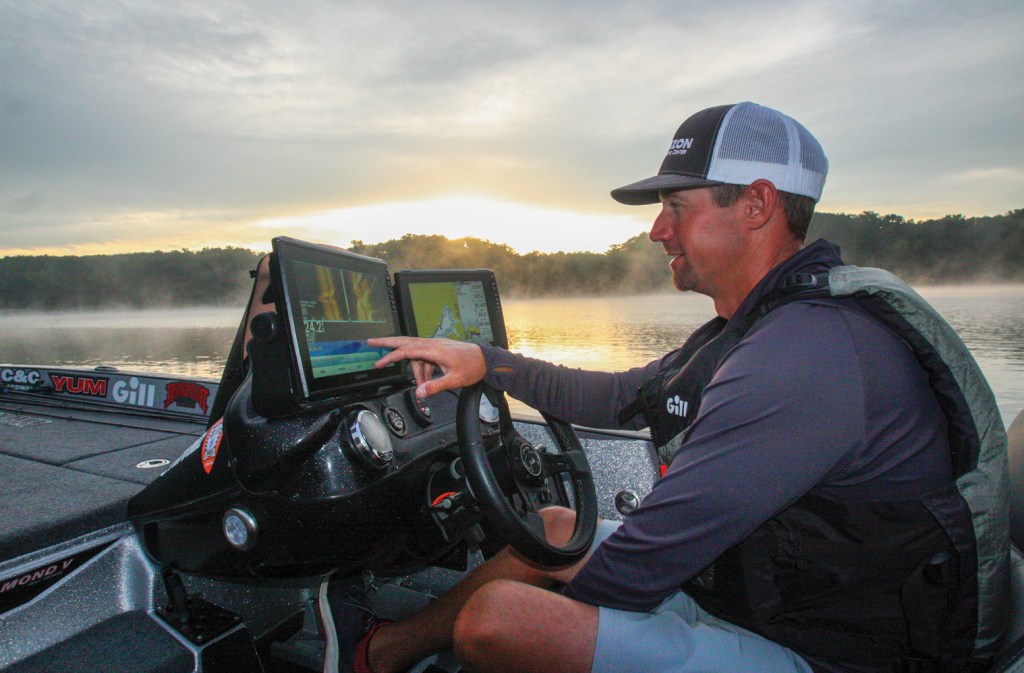
◗ 6:55 a.m. We launch the Phoenix. Palmer checks the water: It’s 80 degrees and stained. “Even though fall is approaching and the lake’s surface temp has undoubtedly cooled off some, the water below the surface is probably still at midsummer temperature levels, so I expect many bass are still offshore. But since I’m basically a shallow-water guy, I’m going to start off by breaking this lake down with shallow lures and approaches that I have a lot of confidence in — regardless how hot it gets, there’s always a population of bass that remain shallow. I’m already seeing a lot of shoreline wood cover, secondary points and riprap that should hold shallow fish.”
◗ 6:59 a.m. Palmer idles straight across the lake and makes his first cast of the day to a laydown on a shallow point with a shad-colored Heddon Zara Spook topwater. Instantly a fish loads on; Palmer swings aboard his first keeper of the day, a 1-pound largemouth. “Catching one on your first cast can be either a great sign or a bad omen!”
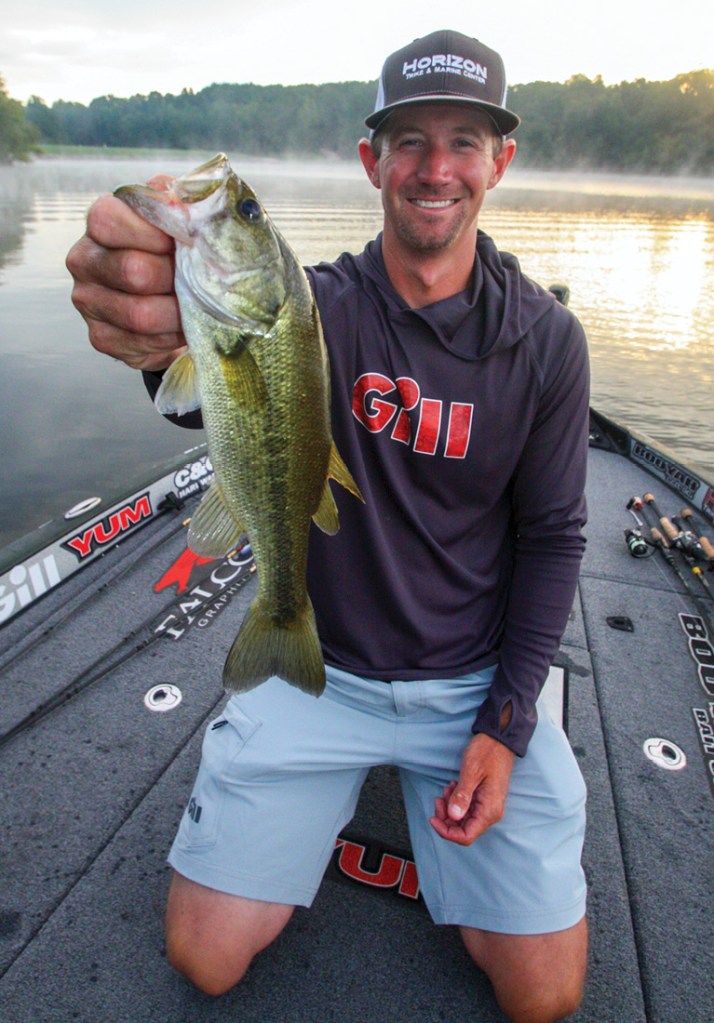
◗ 7:03 a.m. Palmer’s live sonar reveals several fish suspending directly beneath his boat. He lowers a green pumpkin Yum finesse worm on a drop-shot rig to the fish and shakes it repeatedly. They aren’t interested. “Must be crappie.”
◗ 7:11 a.m. Palmer moves to Lake L’s earthen dam and dog-walks the Spook parallel to riprap.
◗ 7:18 a.m. Palmer has traversed the entire length of the dam with the Spook. He moves two castlengths off the structure, scopes some suspending fish and tries the drop-shot worm.
◗ 7:23 a.m. Still nosing around offshore near the dam with his LiveScope sonar, Palmer switches to a shad-colored jerkbait, brand unknown. “When you’re targeting suspended bass, you often need to try a rotation of different lures to get them to bite.”
◗ 7:29 a.m. Palmer races uplake to a rocky point and tries the Spook.
◗ 7:34 a.m. The point transitions into a tributary pocket. Palmer first scopes the entrance to the pocket, then moves shallow to pitch the Spook around docks.
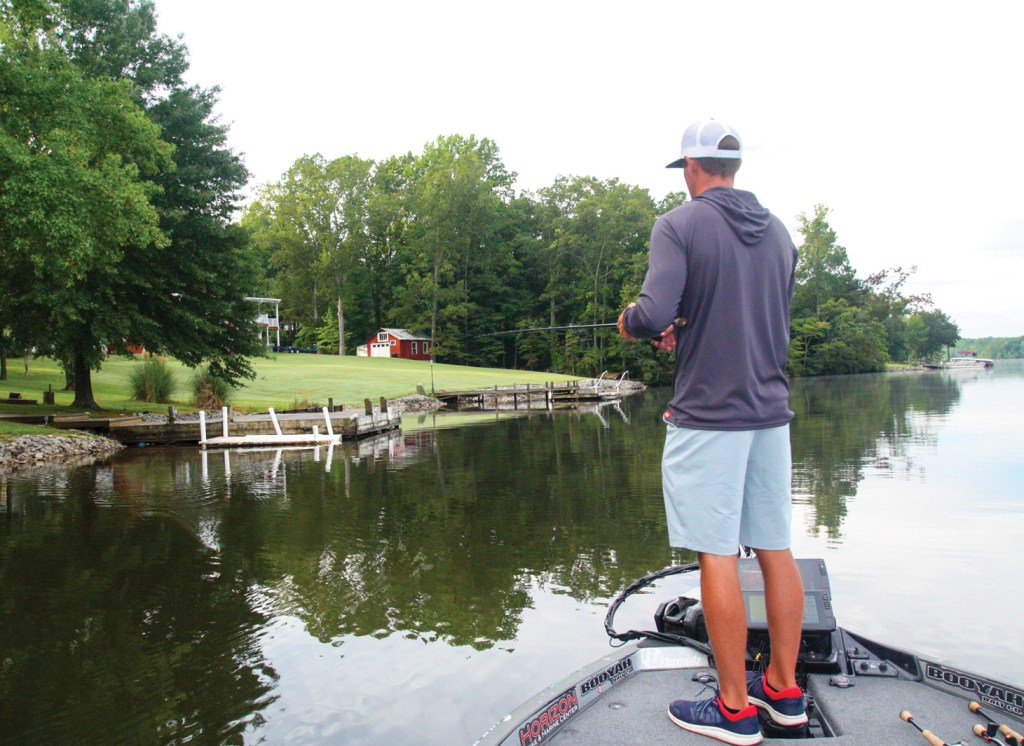
◗ 7:39 a.m. Palmer hops a Texas-rigged Yum Wooly Bug creature bait in the bream color around the pocket. “I scoped a couple fish following the drop-shot worm down as it was sinking. Hopefully, the Bug will trigger them to bite.”
◗ 7:45 a.m. Palmer catches a 10-inch bass on the drop-shot worm. “I shook the worm after it hit bottom, and the fish nailed it. I’m seeing a couple of big blips on the screen mixed in with small fish, so hopefully those are bass and not carp.”
6 HOURS LEFT
◗ 7:55 a.m. Palmer is moving around the pocket at a fast clip while casting the Spook to shallow targets.
◗ 8:08 a.m. Palmer switches his drop-shot worm color to plum and casts the rig to a wooden dock that’s in a sad state of disrepair. “I like these old, decrepit docks; their pilings usually have a thick coating of algae that attracts baitfish.”
◗ 8:11 a.m. Palmer pitches the Wooly Bug beneath the dock, but there are no takers. “Should’ve been one there!”
◗ 8:16 a.m. Palmer rockets uplake to a long, shallow point at the juncture of two feeder creeks. He starts three castlengths offshore, fancasting the Spook while scoping open water for suspending bass.
◗ 8:20 a.m. He shakes the plum finesse worm around some suspended fish and catches a tiny largemouth.
◗ 8:22 a.m. Palmer rigs a green pumpkin Yum Dinger stickworm wacky style (hook through the middle) and inserts a nail weight in the bait’s head. He pitches the faux crawler to suspending fish he’s scoped in 12 feet of water. No takers.
◗ 8:26 a.m. Back to the drop-shot worm. “I’m seeing a lot of scattered fish 8 to 12 feet deep, some suspended and some on bottom. Once the sun gets higher they should bunch up more, which usually makes them easier to catch.”
◗ 8:28 a.m. Palmer scopes a big fish chasing his worm toward the surface as he reels it in; repeated shakes of the lure fail to provoke a strike. “Forward-shooting sonar has been a huge game changer, and this technology is really only in its infancy. I wonder what it’ll be like five or 10 years from now. I can see it getting to the point where even pro anglers say, ‘OK, enough is enough!’”
◗ 8:31 a.m. Palmer rigs a green pumpkin Yum Spine Craw creature on the drop-shot setup and catches a squealer bass.
◗ 8:33 a.m. Palmer switches to the jerkbait off the point. He retrieves it with sharp, rapid jerks. “The hotter the water, the harder I’ll jerk.”
◗ 8:37 a.m. Palmer has scoped a sizable school of fish 50 yards off the point. He catches a small white bass on the jerkbait.
◗ 8:44 a.m. Palmer moves to a stumpy secondary point and tries the Spook.
◗ 8:50 a.m. He bumps the Texas-rigged creature down a long laydown.
5 HOURS LEFT
◗ 8:55 a.m. Palmer progresses quickly up a shallow tributary arm while walking the Spook around shoreline wood cover.
◗ 9:07 a.m. Palmer has moved halfway up the creek while alternating between the Spook and the creature. “There’s a ton of wood back in here, but the fish evidently aren’t on it.”
◗ 9:12 a.m. Palmer’s trolling motor is stirring up mud, but he’s still eyeballing his LiveScope graph. “Forward sonar isn’t just for deep, open water. I use it to spot shallow fish, too. At the last Santee Cooper [South Carolina] tournament, I caught 33 pounds from shallow water — all fish that I scoped before casting to them.”
◗ 9:17 a.m. Palmer switches to a shad-colored Bandit 100 squarebill crankbait and roots it around shallow cover.
◗ 9:22 a.m. He grinds the Bandit across a clay point at the mouth of the tributary.
◗ 9:26 a.m. Palmer downsizes his drop-shot sinker to 1/4 ounce and replaces the finesse worm with a morning dawn-colored Yum Warning Shot worm.
◗ 9:28 a.m. Palmer scopes a school of fish suspended off the point and casts a shad-colored Yum FF Sonar Minnow on a 3/16-ounce head to them.
◗ 9:30 a.m. Back to the Warning Shot. Just as Palmer scopes two big bass moving toward the lure, a Jet Ski runs between his boat and the point, scattering the school! Most anglers would be apoplectic; Palmer calmly reels in and makes another cast. “Two things you can’t control are the weather and Jet Skiers.”
◗ 9:32 a.m. Palmer breaks off the plum finesse worm in a brushpile and reties.
◗ 9:36 a.m. He flips the Wooly Bug around a main-lake boathouse.
◗ 9:41 a.m. Palmer scopes a small pod of suspended fish near the boathouse. He casts the jerkbait and gets a follow, but the fish doesn’t strike. “They’re really in a stupor today!”
◗ 9:44 a.m. Palmer opts to try a Ned rig consisting of a 3-inch green pumpkin Yum Ned Dinger stickworm on a 1/6-ounce head. He casts it to the school and bags his second keeper, 1 pound, 4 ounces. “This fish was on a stump 8 feet deep.”
◗ 9:49 a.m. Palmer idles around open water and locates another wad of suspended fish. He casts the Warning Shot to the piscatorial posse and catches his third keeper, 1 pound, 7 ounces. “They aren’t that big but they do seem to be waking up.”
4 HOURS LEFT
◗ 9:55 a.m. Palmer replaces the Wooly Bug with a
7 1/2-inch red shad Yum Ribbontail worm and casts it to a submerged brushpile. “I’m scoping a couple of big fish around that brush.”
◗ 10:01 a.m. Palmer hops the Ned worm around the brushpile and reels in, and a bass grabs it near the boat. He swings aboard his fourth keeper, 1-1.
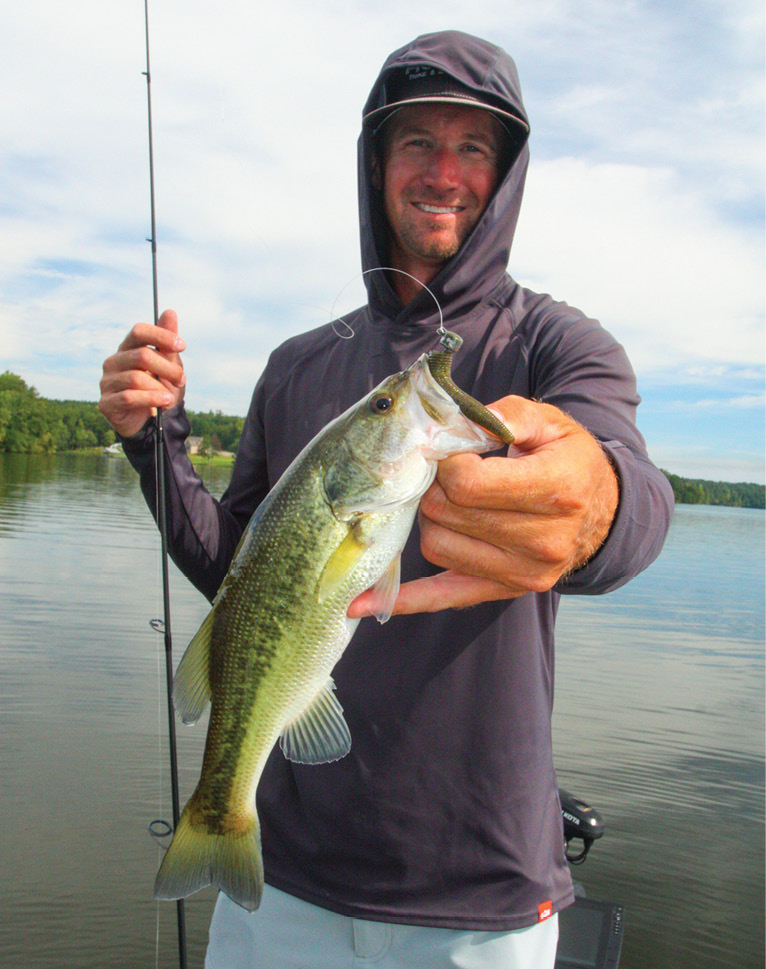
◗ 10:03 a.m. The brushpile gives up Palmer’s fifth keeper, 1-2, also on the Ned worm. “At least I’ve got my limit, but they’re all small. I am scoping some bigger fish, however.”
◗ 10:15 a.m. Palmer bags his sixth keeper, 1-3, off the brushpile on the Ned worm; it culls the keeper he caught on his first cast. What’s his take on the day so far? “These fish have not progressed out of their midsummer pattern nearly as much as I’d hoped. They’re roaming around searching for baitfish and they’re not stacked up in big schools. I’m not finding a whole lot of structure besides points in this lake, either. I’m probably not fishing deep enough, but hitting that 15- to 25-foot zone isn’t my strength. In conditions this tough, a couple of 3- to 4-pounders can go a long way, so I’m going to idle around a little more and see if I can’t tap into some bigger fish.”
◗ 10:25 a.m. Palmer moves into Lake L’s eastern fork, where he casts the Ribbontail worm around laydowns.
◗ 10:31 a.m. He catches keeper No. 7, 1-1, from an open-water school on the Ned rig. It’s no help to his weight total. “These fish all came out of the same mold!”
◗ 10:40 a.m. Palmer continues to probe the offshore school with the Ned worm.
3 HOURS LEFT
◗ 10:55 a.m. Palmer drags the red shad drop-shot worm around an offshore rockpile. Nothing here.
◗ 11:16 a.m. He catches keeper No. 8, 1-9, off a dock on a black and blue Yum Thump’n Dinger drop-shot worm.
◗ 11:20 a.m. Palmer runs downlake into a tributary arm. He switches Ribbontail worm colors to black and blue and casts it around a pod of suspended fish.
◗ 11:25 a.m. Palmer probes a high spot in the middle of the tributary with the Ribbontail and Thump’n Dinger.
◗ 11:32 a.m. He cranks the squarebill around shoreline rocks.
◗ 11:38 a.m. It’s stifling hot and humid as Palmer drags the drop-shot finesse worm around the rocks. “September can be miserable! You think fall is finally here, but you’re wrong!”
◗ 11:44 a.m. Palmer moves to a nearby boathouse. He pitches the black and blue finesse worm to the structure, hops it after it sinks, then spots a giant bass following the lure as he quickly reels it back in. “Oh, man, that was a 7-pounder! And I’m seeing six more big fish under this dock on LiveScope!”
◗ 11:50 a.m. Palmer quickly ties up a fresh finesse rig consisting of 12-pound braid (main line) and 8-pound fluorocarbon (leader). On the business end is a wacky-rigged black and blue Yum finesse worm.
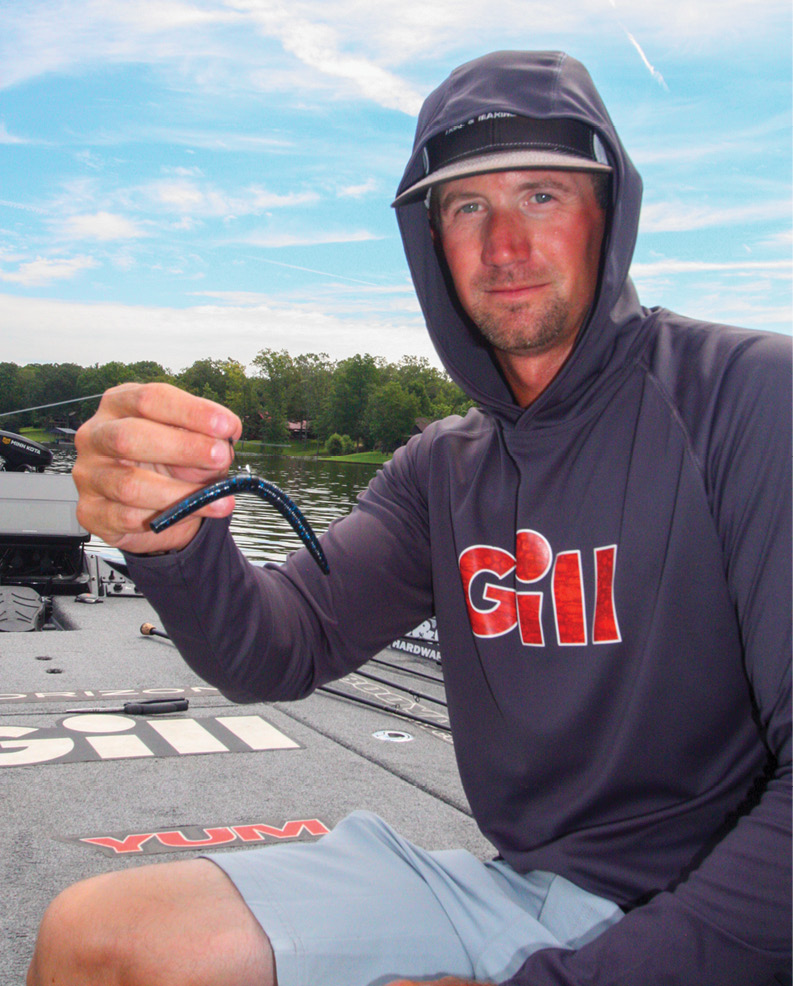
2 HOURS LEFT
◗ Noon. Palmer has made repeated casts with the wacky worm into and around the boathouse without contacting another fish. “I’m still seeing big ones on LiveScope, but it’s like they’re frozen.”
◗ 12:21 p.m. Palmer abandons the boathouse, runs straight across the creek arm and catches his ninth keeper, 1 pound, off a dock on the Thump’n Dinger. It’s a cull.
◗ 12:29 p.m. Palmer is moving rapidly along a series of docks with the wacky worm and Thump’n Dinger.
◗ 12:44 p.m. Palmer moves to another stretch of docks and catches a short fish on the wacky worm.
1 HOUR LEFT
◗ 12:55 p.m. Palmer moves to a flat point at the entrance to the tributary and catches a nonkeeper off a stump on the wacky worm.
◗ 12:59 p.m. He races back to the boathouse where he spotted the 7-pounder and pitches the wacky worm to the structure. “I’m still scoping those big bass under this boathouse, but they’re totally unresponsive.”
◗ 1:10 p.m. Palmer zips to a nearby island and casts the wacky worm around some laydowns.
◗ 1:14 p.m. He moves to a channel bank and pitches the Ribbontail to more submerged trees.

◗ 1:25 p.m. Palmer has raced uplake to a tributary point he fished earlier. He scopes a pod of offshore fish 50 yards from the point, casts the Ribbontail to the school and gets a hard strike. Palmer slams back his rod, reels quickly and swings aboard his 10th keeper, a 4-1 largemouth. “Yes! I needed that one! I scoped it swimming down to the bottom to grab the worm.”

◗ 1:31 p.m. Palmer bags a short fish on the Ribbontail.
◗ 1:36 p.m. He catches a 1-pound keeper (No. 11) on the Ned worm — no help.
◗ 1:43 p.m. Palmer catches keeper No. 12, 1-1 on the Ribbontail; it’s also a cull.
◗ 1:49 p.m. Palmer races to a nearby secondary point and makes his final casts of the day with the Ribbontail.
◗ 1:55 p.m. Time’s up! Palmer has racked up 12 keepers from Lake L. His five biggest fish weigh
9 pounds, 8 ounces.
THE DAY IN PERSPECTIVE
“I caught a fair number of fish today, but I sure could have used a couple more big ones,” Palmer told Bassmaster. “I think the bigger fish are still on their midsummer pattern, in or around deeper water than I was fishing. If I were to fish here tomorrow under these same conditions, I’d start hitting docks earlier, knowing that they have the potential to hold multiple big fish, and I’d also adjust to a slightly deeper offshore pattern than the 8- to 12-foot zone I was mainly fishing.”
WHERE AND WHEN LUKE PALMER CAUGHT HIS FIVE BIGGEST BASS
1 pound, 4 ounces; green pumpkin Yum Ned Dinger worm on 1/6-ounce head; offshore stump; 9:44 a.m.
1 pound, 7 ounces; morning dawn Yum Warning Shot worm on drop-shot rig; open water; 9:49 a.m.
1 pound, 3 ounces; same lure as No. 1; offshore brushpile; 10:15 a.m.
1 pound, 9 ounces; black and blue Yum Thump’n Dinger worm on drop-shot rig; dock; 11:16 a.m.
4 pounds, 1 ounce; black and blue Yum Ribbontail worm Texas-rigged on 3/0 hook with 1/4-ounce sinker; offshore near point; 1:25 p.m.
TOTAL: 9 POUNDS, 8 OUNCES

